|
An EMBOK
Research Menu
July 10, 2006
EMBOK Day at the 2006
Las Vegas International Hospitality and Convention Summit, held June 6th
at the University of Nevada, Las Vegas (UNLV), included vibrant discussions
surrounding the scope and validity of the International EMBOK Model and strategies for its improvement and adoption by
a broad variety of academic and industry stakeholders. One of the suggestions
that resonated for the academic participants was to create a research menu based
on the EMBOK that would provide students with viable research topics that would
be of value to the industry.
Creating new knowledge through
research is a significant link between academia and industry, providing students
with learning opportunities and industry practitioners with data that can serve
as a foundation for good decision making, event development, and strategies for
continuous improvement. This was, in fact, one of the uses conceived for the
Event Management Body of Knowledge, a knowledge framework and descriptive
summary of the scope and processes that are used in the management of events
that may be customized to meet the needs of various cultures, governments,
education programs, and organizations.
The research menu presented
here is an illustration of how the International EMBOK Model may be approached
when seeking topics for research that will quantify, qualify, verify, or
validate commonly held beliefs and practices that industry practitioners have
acquired throughout their careers, turning the “school of hard knocks” into hard
science. This research may be conducted within the academic realm as well as by
associations that serve various industry sectors. Research data from both
sources will contribute to the body of knowledge and will serve current and
future practitioners, as well as event consumers through improved standards of
practice.
This knowledge will provide
important guidance to organizers and authorities. For example, studying the
number of on-site ambulances included at various event types and sizes could
provide standardized guidance for new events. Such data could be collected from
the historical records kept by ambulance services, which might serve as a
foundation for best practice or regulatory standards that would protect the
health and safety of consumers at public events.
The EMBOK Matrix as shown
below is comprised of Sectors and Domains (with their functional areas, referred
to as Classes) and offers hundreds, even thousands of research opportunities.
The EMBOK Matrix identifies 280 fields of inquiry, or 360 fields of inquiry with
the Phases and Core Values included. One square within the Matrix indicates a
single Class for a single Sector; one row indicates a single Class across all
Sectors. Within each Class there may be countless elements (as illustrated in
the
Silvers Taxonomy comprised of approximately 600 items), but even with a
simplified estimate of five elements per Class (e.g. Food & Beverage*: food
service scope, catering operation selection, menu selection, service planning,
and alcohol management) the number of discrete fields of inquiry jumps to 1,400.
*Food
& Beverage has replaced Catering in the Design Domain in the original EMBOK
Model due to the varying definitions of catering throughout the global industry.
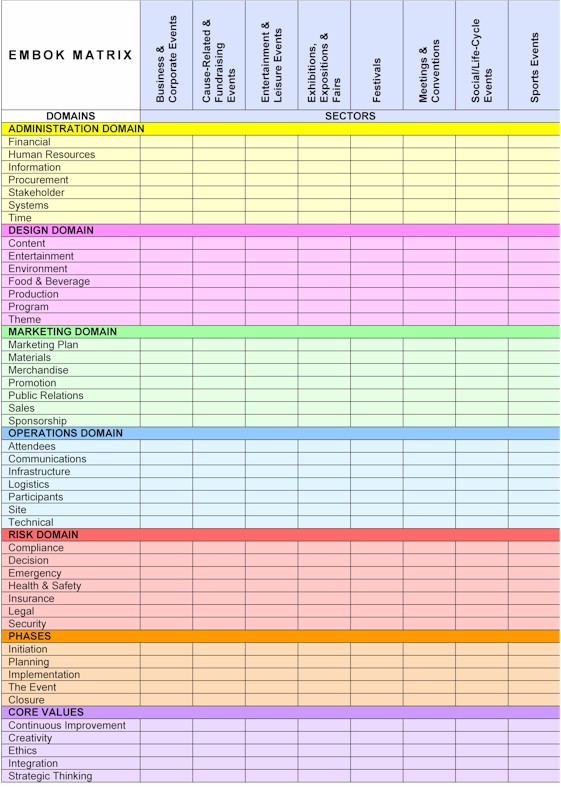
One may approach the
topics within a single industry sector (e.g. Meetings and Conventions or
Sports Events), or comparisons between sectors or across all sectors. Such
comparative analyses will enhance understanding of the horizontal and
vertical nature of the overall events industry, as illustrated below. Many
goods and services are used in a variety of event sectors, and data that
identifies the similarities and differences between all sectors will not
only help to illustrate the scope of the events industry as a whole, it will
reveal opportunities for organizers and providers alike.
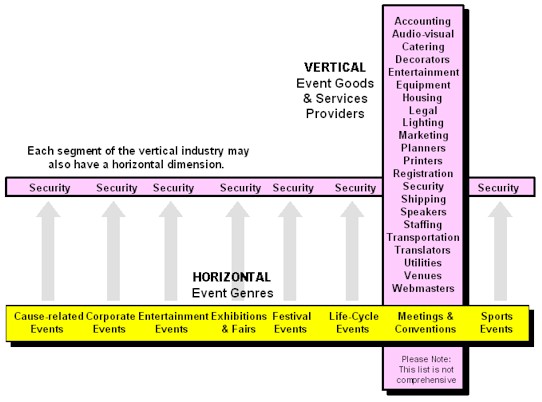
It should be readily
apparent that the scope of research, both possible and desirable, is vast. A
single square within the EMBOK Matrix offers researchers rich opportunities
for discoveries to dissertations, through which the EMBOK will raise the
stature and standards of the events industry and all its inhabitants.
Matrix Research
Opportunities
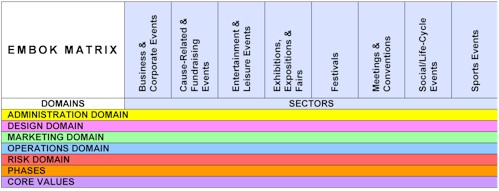
-
The applicability and
usage of the scope of the EMBOK Domains in the various industry Sectors
-
Comparative analysis
of the EMBOK Phases in the various industry Sectors
-
Comparative analysis
of the EMBOK Core Values in the various industry Sectors
Administration Domain
Research Opportunities

-
The application of the
EMBOK Administration Domain Classes in the various industry Sectors
-
Analysis of the scope
of the EMBOK Administration Domain in individual industry Sectors
-
Job analysis of the
EMBOK Administration Domain Classes in the various/individual industry
Sectors
-
Best practices in the
EMBOK Administration Domain Classes in various/individual industry
Sectors
-
Comparative analysis
of EMBOK Administration Domain Classes in the various/individual
industry Sectors
Examples
|
Financial
|
Cash flow analysis
Bookkeeping
procedures
Pricing strategies |
|
Human Resources
|
Recruitment and
selection procedures
Volunteer usage
Compensation
strategies |
|
Information
|
Specifications
guides / production books
Data reporting and
monitoring procedures
Privacy policies
and procedures |
|
Procurement
|
Procurement
policies and procedures
RFP/bid
solicitation usage
Selection and
evaluation criteria development |
|
Stakeholder
|
Governance systems
Constituency
management
Coalition building
strategies |
|
Systems
|
Information
software/technology systems
Communication
systems
Quality management
systems |
|
Time
|
Activity
definition procedures
Schedule
development tactics
Change control
systems |
Design Domain Research
Opportunities
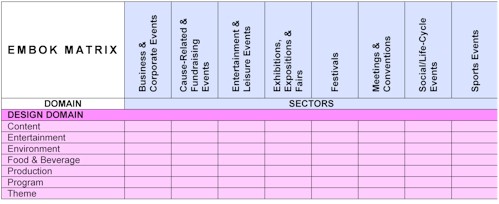
-
The application of the
EMBOK Design Domain Classes in the various industry Sectors
-
Analysis of the scope
of the EMBOK Design Domain in individual industry Sectors
-
Job analysis of the
EMBOK Design Domain Classes in the various/individual industry Sectors
-
Best practices in the
EMBOK Design Domain Classes in the various/individual industry Sectors
-
Comparative analysis
of EMBOK Design Domain Classes in the various/individual industry
Sectors
Examples
|
Content
|
Content
development criteria and procedures
Content delivery
format selection process
Accreditation
requirements |
|
Entertainment
|
Entertainment and
attraction selection criteria
Ancillary
programming
Cost/benefit
analysis of entertainment and attractions |
|
Environment
|
Marketing and
communication environments
Seating
arrangement effect on learning environments
Wayfinding systems |
|
Food & Beverage
|
Impact of food
allergies on menu planning
Concession
operations
Alcohol service
policies |
|
Production
|
Trends in
audiovisual and multimedia equipment usage
Decorative, task,
and safety lighting strategies
Soundscaping and
scentscaping practices |
|
Program
|
Program
composition and sequencing procedures
Protocol for
ceremonies
Specialty services
and amenities for attendees and participants
|
|
Theme |
Theme selection
and development procedures
Cultural
iconography and branding imagery usage
Theme integration
tactics
|
Marketing Domain Research
Opportunities
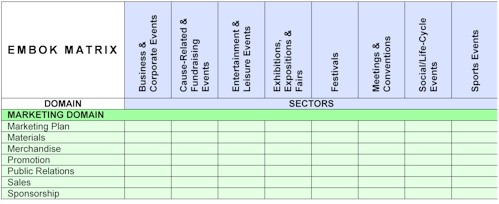
-
The application of the
EMBOK Marketing Domain Classes in the various industry Sectors
-
Analysis of the scope
of the EMBOK Marketing Domain in individual industry Sectors
-
Job analysis of the
EMBOK Marketing Domain Classes in the various/individual industry
Sectors
-
Best practices in the
EMBOK Marketing Domain Classes in the various/individual industry
Sectors
-
Comparative analysis
of EMBOK Marketing Domain Classes in the various/individual industry
Sectors
Examples
|
Marketing Plans |
Marketing
objectives and measurement strategies
Message and
branding criteria development
Integrated
marketing tactics |
|
Materials |
Scope and purpose
of printed materials
Content and layout
selection procedures
Distribution
schedules and methods |
|
Merchandise |
Product
development criteria
Brand management
Inventory
management |
|
Promotion |
Advertising
methods and mediums
Cross-promotions
criteria and strategies
Contest design and
implementation procedures |
|
Public Relations |
Publicity
strategies and measurement
Media relations
activities
Crisis and
controversy management |
|
Sales |
Registration and
ticketing operations
Sales platforms
and technologies
Transaction
procedures |
|
Sponsorship |
Commercial
sponsorship criteria and development
Donor cultivation
strategies
Ambush marketing
controls |
Operations Domain Research
Opportunities

-
The application of the
EMBOK Operations Domain Classes in the various industry Sectors
-
Analysis of the scope
of the EMBOK Operations Domain in individual industry Sectors
-
Job analysis of the
EMBOK Operations Domain Classes in the various/individual industry
Sectors
-
Best practices in the
EMBOK Operations Domain Classes in the various/individual industry
Sectors
-
Comparative analysis
of EMBOK Operations Domain Classes in the various/individual industry
Sectors
Examples
|
Attendees |
Admittance and
credentialing systems
Crowd movement and
flow
Arrival and
departure density |
|
Communications |
Communication
methods and modalities
Briefings and
announcement procedures
Command and
control strategies |
|
Infrastructure |
Traffic impact and
management strategies
Utilities usage
and augmentation
Waste management
strategies |
|
Logistics |
Task analysis and
sequencing procedures
Contractor
coordination
Move-in, move-out,
and maintenance practices |
|
Participants |
Hospitality
requirements for participants
Celebrity or
dignitary inclusion and impact
Selection criteria
and procedures for officials and officiates
|
|
Site |
Site sourcing
trends and practices
Site selection
criteria development and procedures
Site development
systems |
|
Technical |
Staging solutions
for site enhancement
Trends in
production technology usage
Technician support
demand |
Risk Domain Research
Opportunities
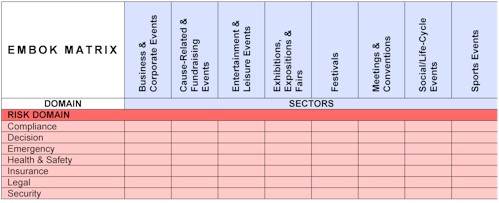
-
The application of the
EMBOK Risk Domain Classes in the various industry Sectors
-
Analysis of the scope
of the EMBOK Risk Domain in individual industry Sectors
-
Job analysis of the
EMBOK Risk Domain Classes in the various/individual industry Sectors
-
Best practices in the
EMBOK Risk Domain Classes in the various/individual industry Sectors
-
Comparative analysis
of EMBOK Risk Domain Classes in the various/individual industry Sectors
Examples
|
Compliance |
Applicable
statues, codes, and regulations
Accessibility
compliance strategies
Intellectual and
property rights observance |
|
Decision |
Risk assessment
procedures
Decision making
criteria and restraints
Authority and
accountability controls |
|
Emergency |
Medical services
provision
Emergency action
plans
Disaster recovery
and business continuity plans |
|
Health & Safety |
Fire and life
safety evaluations
Occupational
health and safety practices
Crowd behavior and
control strategies |
|
Insurance |
Risk financing
strategies
Liability
exposures
Insurance coverage |
|
Legal |
Contract execution
criteria and procedures
Licensing
requirements
Policy development
and implementation process |
|
Security |
Security personnel
and equipment selection
Security
deployment criteria
Command and
control system |
Additional Matrix Applications
Each Class in each Domain has
an impact on and will be impacted by every other Class.
One may examine the impact of one row (e.g. Administration: Financial), which
represents 34 points of consideration. The entire matrix of Domain Classes
represents 1,190 points of consideration, and when the five Phases of the EMBOK
are added, represents a minimum of 5,950 points of consideration. When this is
compounded by a minimum of five elements per Class (e.g. employees, volunteers,
union workers, temporary staff, etc. plus structure of authority, job
assignments, job descriptions, etc. all under Administration: Human Resources),
one is looking at a minimum of 29,750 points of consideration, and more likely
twice to ten times that many "decisions" to be made for a single event.
Although much of this analysis is done almost unconsciously and rarely
documented by most practitioners, such documentation facilitates knowledge
transfer and provides evidence of due diligence.

The International EMBOK
Model, comprised of Processes, Phases, Domains, and Core Values, may be used
to create a matrix showing tasks for each element of each Class of each
Domain. When extrapolated out to analysis of a single event, such a matrix
would provide an operational register with 4,375 points or opportunities for
continuous improvement.

What has yet to be
identified, however, are the scale variables that will allow events to be
fully classified. The scale of an event could be small, medium, large, or
mega (or other designations) and the challenge will be putting agreed-to
numbers to these qualifiers. Some governments have used attendance numbers
as the baseline for certain statutory requirements. South Africa’s new
Sports and Safety legislation, for example, requires a “qualified event
organizer” (among other things) for any event of 2,000 people or more.
The sheer volume of
research to be done may seem overwhelming. However, as academic programs in
events management and events of all sizes and types proliferate throughout
the world, this becomes a wealth of opportunity rather than a burden.
Let’s go
to work!!
Comments provided by Philip Mondor, Vice President of the Canadian
Tourism Human Resource Council:
"Thank you for
providing this paper; it was a pleasure to read. To follow are my key
reflections on the model and ideas presented in the
EMBOK Research Menu (10 July
2006) document.
Scope and
Validity
Two themes
resonate in the document – scope and validity. It would be beneficial to
articulate the objectives for each of these as it will help place focus
on the types of research that will be pursued and lend clarity to the
overall goal.
For example,
in terms of scope, are the objectives to:
Ensure
the framework contains a complete, comprehensive listing of domains and
related elements? This may include the goal to ensure the
range of domains and related competencies are exhaustive, and/or a
greater level of specificity (such as clarifying the level at which the
elements are performed) and/or classifying of the elements to describe
type (such as transferable or core versus specialty; or frequency,
importance, cognitive taxonomy, level of difficulty and so on).
Verify
the application and relevance of EMBOK to (a) educational
pursuits, (b) employment opportunities, (c) research and academic
endeavors, (d) policy…? (*these are
mere examples)
Promote
learner and labour mobility, i.e. for EMBOK to inform (or be) a type of
qualifications framework? (For example, OECD defines
qualifications framework as “an instrument for the development and
classification of qualifications according to a set of criteria for
levels of learning achieved. This set of criteria may be implicit in the
qualifications descriptors themselves or made explicit in the form of a
set of level descriptors. The scope of frameworks may be comprehensive
of all learning achievements and pathways or may be confined to a
particular sector for example initial education, adult education and
training or an occupation area. Some frameworks may have more design
elements and a tighter structure than others; some may have a legal
basis whereas others represent a consensus of views of social partners”.
OECD further asserts that all qualifications frameworks establish a
basis for improving the quality, accessibility, linkages and public or
labour market recognition of qualifications within a country and
internationally. (For another good example, take a look at the
International Labour Organization’s definition.)
If the
objectives related to scope are well understood, then there is a clearer
sense of what must be achieved in validation of the model. Validation,
after all, must be linked to these objectives. Validation efforts to
affirm completeness, for example, are different than validation efforts
concerning application of the model. Methodologies will vary because of
different objectives and necessitated by the different types of
stakeholders, as well different opportunities and constraints.
Classification
Decisions
Classification
systems are fascinating and organic by nature. Classification systems
however should not be accidental and special care is needed to ensure
decisions on how data is labeled are deliberate. This is no easy task,
especially in models that are intended to convey universal concepts and
have international currency. One way to defend classification labels is
to carefully define them and where possible to articulate the criteria
or defense to come to those decisions.
One example I
reflected on concerns the list of events sectors (which I think is also
referred to as event genres
in the document). To a lay reader of the model, an inevitable question
is “How did they come to the conclusion of these particular sectors?”
Was it the size or scale of event, duration or other type of criteria,
for example? Perhaps the list was compiled as a result of other data or
models. Regardless, it is helpful to include some rationale for the
sector choices and definitions of the respective sectors to ensure
clarity.
Other examples
of terms that I think would be beneficial to define include: domain,
domain classes, fields of inquiry, class or function. Terms and
technical language that is universal in nature will assist in garnering
serious interest and possibly even adoption or use of EMBOK. (Perhaps
one of the validation efforts concerns the validation of terms and
concepts.)
Research
The paper
inspires many ideas on possible research that could be undertaken which
would contribute to the EMBOK model. To some extent, the very body of
this research may help validate the model (i.e. in terms of
demonstration on the application of the framework), and at the same time
the research will help refine the model. As I understand it, it is this
very type of research that the paper is promoting.
Here are some
other research propositions:
-
Articulation and verification of types
of evidence or indicators that could be used to assess if an
individual meets the skill or competency. (Or this same idea, but
looking at it from an event level rather than an individual level.)
-
Mapping or articulation that shows the
link to common types of skills or areas where one skill is dependent
upon another… many other possible variables, but essentially the
idea to show where there are commonalities and currency. (This very
exercise is another form of validation.) This could include the
defining of core competencies/requirements.
-
On a similar vain, exploring what is
transferable to other occupational domains or economic sectors.
-
Exploring the underpinning skills or
competency requirements, i.e. what is necessary for entry (not just
expert level).
-
Validation of industry terms, concepts
and jargon.
-
Defining and applying a taxonomy for
each of the competencies (which is necessary if one wants to get to
assessment of events practitioners, and very helpful in informing
curriculum and training initiatives).
-
Adaptation to another language and the
validation efforts that go into adaptation of such a model.
-
Specific development efforts with
respective events-focused bodies such as tertiary educational
institutions that specialize in the events discipline, or
accrediting and certifying bodies. (These bodies could identify what
is most important to them, and this would serve as a subject of
inquiry… thus aiding in getting interest and buy-in as well.)
-
Defining of quality assurance measures.
-
Comparative work with other body of
knowledge frameworks.
…of course the
list could go indefinitely.
Summary Point
The very fact
that there are many robust ideas that can be generated and an
appreciation for the complexity that the model presents reinforces its
value and the need for additional exploration. I really like the example
that is positioned in the fourth paragraph, i.e. guiding organizers and
authorities with respect to use of ambulances. Indeed many other
illustrations could be talked about, but the point is there is a need
for agreement and relevant data that will help inform better practices."
|











